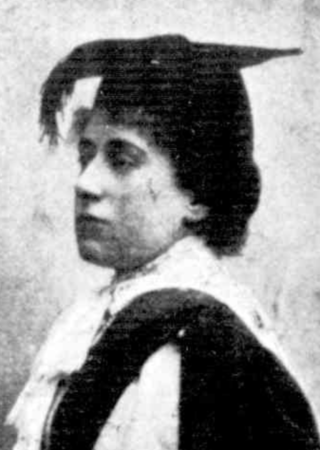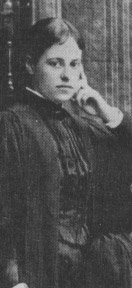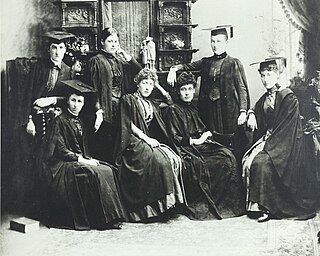
Trinity College is the oldest residential college of the University of Melbourne, the first university in the colony of Victoria, Australia. The college was opened in 1872 on a site granted to the Church of England by the government of Victoria. In addition to its resident community of 380 students, mostly attending the University of Melbourne, Trinity's programs includes the Trinity College Theological School, an Anglican training college which is a constituent college of the University of Divinity; and the Pathways School which runs Trinity College Foundation Studies and prepares international students for admission to the University of Melbourne and other Australian tertiary institutions, as well as summer and winter schools for young leaders and other short courses.

Constance Ellis was an Australian medical doctor who specialised in obstetrics, gynaecology and pathology. In 1903 she became the first woman to graduate from the University of Melbourne as a Doctor of Medicine.
The London School of Medicine for Women (LSMW) established in 1874 was the first medical school in Britain to train women as doctors. The patrons, vice-presidents, and members of the committee that supported and helped found the London School of Medicine for Women wanted to provide educated women with the necessary facilities for learning and practicing midwifery and other branches of medicine while also promoting their future employment in the fields of midwifery and other fields of treatment for women and children.

Emma Constance Stone was the first woman to practice medicine in Australia. She played an important role in founding both the Queen Victoria Hospital, and the Victorian Medical Women's Society in Melbourne.
Dame Ella Annie Noble Macknight, DBE, MRCOG, FRCOG, FAMA, FAGO was an Australian obstetrician and gynaecologist who worked at the Queen Victoria Hospital, Melbourne. She was appointed as a Dame Commander of the Order of the British Empire on 1 January 1969 for services to medicine.
Major General Sir William Dudley Duncan Refshauge, was an Australian soldier and public health administrator. He was Honorary Physician to Queen Elizabeth II (1955–64), director-general of the Australian Government Department of Health (1960–73), and secretary-general of the World Medical Association (1973–76).

Sir John Harold Peel was a leading British obstetrician and gynecologist, who was Surgeon-Gynaecologist to Elizabeth II from 1961 to 1973, present at a number of royal births.
Doris Clifton Gordon was a New Zealand doctor, university lecturer, obstetrician and women's health reformer. She was known as 'Dr Doris', famous for her work in rural general practice, for raising the status of obstetrics, improving obstetrics education of medical students and doctors, and working for the welfare of mothers and children.

Lilian Helen Alexander was an Australian surgeon and one of the first women to study medicine at the University of Melbourne.

Janet Lindsay Greig was a Scottish-Australian anaesthetist. In 2007, she was inducted into the Victorian Honour Roll of Women.

Jane Stocks "Jean" Greig was a Scottish-Australian medical doctor and public health specialist.

Emily Mary Page Stone MBBS, generally referred to as Mary or E. Mary Page Stone, was a medical doctor in the State of Victoria, Australia.
Lorna Lloyd-Green, was an Australian obstetrician-gynecologist and the president of the Medical Women's International Association from 1968 to 1972. She was the first woman to be elected a fellow of the Australian Medical Association. As one of the first women physicians in Melbourne, she advocated for women in medicine throughout her career, and is credited for playing the principal role in achieving equal pay for women physicians in Australia.
The Victorian Medical Women's Society (VMWS) is the longest-running association of women medical practitioners and medical students. It was established in Melbourne, Australia in 1896 and is one of the oldest active medical organisations in the world. The aim of the society was to set a benchmark in women's health around Victoria, and to advance the professional development of medical women, through education, research, and the improvement of professional opportunities. The state-run society became affiliated with the national body, Australian Federation of Medical Women, and thereby the Medical Women's International Association.

Hannah Mary Helen Sexton, known as Helen Sexton, was an Australian surgeon. After retiring from a surgical career in Melbourne, she opened a field hospital in France during World War I.

Grace 'Clara' Stone was a medical doctor from Melbourne Australia, who was one of the founders of the Queen Victoria Hospital and she was a co-founder, and the first president, of the Victorian Medical Women's Society. She was also in the group of seven women who successfully fought the ban against women studying medicine at Melbourne University in 1887, she was one of the first two women to graduate as a doctor in 1891.
Ethel May Vaughan-Sawyer was a British gynaecological surgeon. She was described by pioneering physician and feminist Louisa Garrett Anderson as "100 times better at her work than I am". A champion of women's rights to work and take part in political life, Vaughan-Sawyer described herself as an example of "healthy normal womanhood usefully and happily employed".

Annie Genevieve O'Hara MB was a doctor from Melbourne, Australia who was a founding member of the Victorian Medical Women's Society, and in 1887 she was one of the first seven women who enrolled in medicine at the University of Melbourne. She graduated in 1894 and commenced practice, however, in 1897 she contracted a cold and died at 27 years of age.












